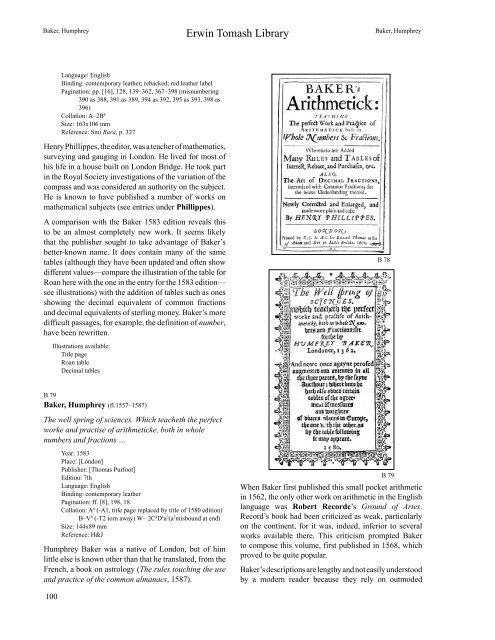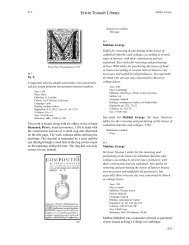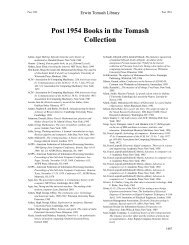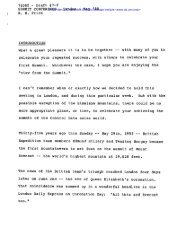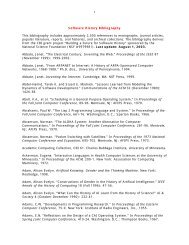B chapter.indd - Charles Babbage Institute - University of Minnesota
B chapter.indd - Charles Babbage Institute - University of Minnesota
B chapter.indd - Charles Babbage Institute - University of Minnesota
You also want an ePaper? Increase the reach of your titles
YUMPU automatically turns print PDFs into web optimized ePapers that Google loves.
100<br />
Erwin Tomash Library<br />
Baker, Humphrey Baker, Humphrey<br />
Language: English<br />
Binding: contemporary leather; rebacked; red leather label<br />
Pagination: pp. [16], 128, 139–362, 367–398 (misnumbering<br />
390 as 388, 391 as 389, 394 as 392, 395 as 393, 398 as<br />
396)<br />
Collation: A–2B 8<br />
Size: 163x106 mm<br />
Reference: Smi Rara, p. 327<br />
Henry Phillippes, the editor, was a teacher <strong>of</strong> mathematics,<br />
surveying and gauging in London. He lived for most <strong>of</strong><br />
his life in a house built on London Bridge. He took part<br />
in the Royal Society investigations <strong>of</strong> the variation <strong>of</strong> the<br />
compass and was considered an authority on the subject.<br />
He is known to have published a number <strong>of</strong> works on<br />
mathematical subjects (see entries under Phillippes).<br />
A comparison with the Baker 1583 edition reveals this<br />
to be an almost completely new work. It seems likely<br />
that the publisher sought to take advantage <strong>of</strong> Baker’s<br />
better-known name. It does contain many <strong>of</strong> the same<br />
tables (although they have been updated and <strong>of</strong>ten show<br />
different values—compare the illustration <strong>of</strong> the table for<br />
Roan here with the one in the entry for the 1583 edition—<br />
see illustrations) with the addition <strong>of</strong> tables such as ones<br />
showing the decimal equivalent <strong>of</strong> common fractions<br />
and decimal equivalents <strong>of</strong> sterling money. Baker’s more<br />
difficult passages, for example, the definition <strong>of</strong> number,<br />
have been rewritten.<br />
Illustrations available:<br />
Title page<br />
Roan table<br />
Decimal tables<br />
B 79<br />
Baker, Humphrey (fl.1557–1587)<br />
The well spring <strong>of</strong> sciences. Which teacheth the perfect<br />
worke and practise <strong>of</strong> arithmeticke, both in whole<br />
numbers and fractions …<br />
Year: 1583<br />
Place: [London]<br />
Publisher: [Thomas Purfoot]<br />
Edition: 7th<br />
Language: English<br />
Binding: contemporary leather<br />
Pagination: ff. [8], 198, 18<br />
Collation: A 8 (-A1, title page replaced by title <strong>of</strong> 1580 edition)<br />
B–V 8 (-T2 torn away) W– 2C 8 D 6 a 2 (a 2 misbound at end)<br />
Size: 144x89 mm<br />
Reference: H&J<br />
Humphrey Baker was a native <strong>of</strong> London, but <strong>of</strong> him<br />
little else is known other than that he translated, from the<br />
French, a book on astrology (The rules touching the use<br />
and practice <strong>of</strong> the common almanacs, 1587).<br />
B 78<br />
B 79<br />
When Baker first published this small pocket arithmetic<br />
in 1562, the only other work on arithmetic in the English<br />
language was Robert Recorde’s Ground <strong>of</strong> Artes.<br />
Record’s book had been criticized as weak, particularly<br />
on the continent, for it was, indeed, inferior to several<br />
works available there. This criticism prompted Baker<br />
to compose this volume, first published in 1568, which<br />
proved to be quite popular.<br />
Baker’s descriptions are lengthy and not easily understood<br />
by a modern reader because they rely on outmoded


